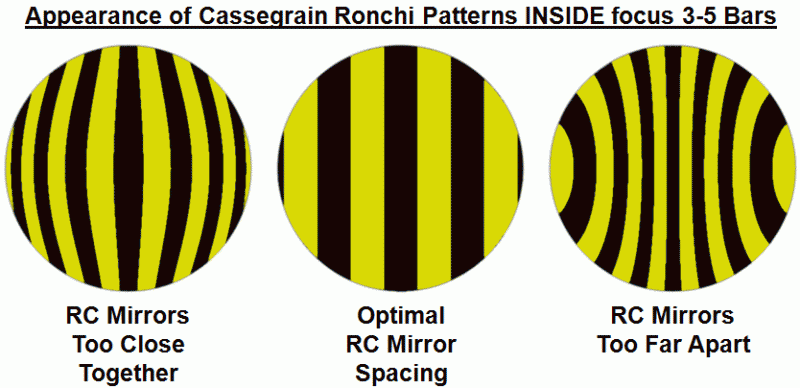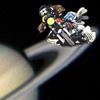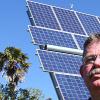Precise RC mirror spacing
#1

Posted 21 June 2013 - 06:00 PM
So, is there any way to find the precise values for these measurements by simple means?
Where are these values measured from on the primary? (The front edge of the primary at the edge of the central hole? The imaginary center of the primary? Presumably the critical point for spacing on the 2ndary is its center.)
Also, if the spacing is off by 1/8" or even 1/4" is that going to lead to very bad results or just sub-optimal, but not too bad results?
BTW: I did fire off an email to Star Instruments asking them about this.
Thanks!
(Getting nervous about the challenge of collimating these mirrors based on what I've read elsewhere....)
John
#2

Posted 21 June 2013 - 06:31 PM
My modest experience with cassegrains and RC's is that collimation in not too difficult. DK's were the fussiest of the bunch.
JimC
#3

Posted 21 June 2013 - 06:43 PM
(Before Star moved to GA, they were within driving distance; not now.)
John
#4

Posted 21 June 2013 - 07:06 PM
JimC
#5

Posted 21 June 2013 - 07:21 PM
Mike Jones is the one to contact on this issue IMHO...
He was of untold help with our 20" RC build!!!
Best Regards,
Preston
#6

Posted 21 June 2013 - 07:30 PM
I'm not sure I can figure out a way to measure the distance between primary and secondary to 0.001"s (especially when they're mounted inside a closed tube)!
Is Mike Jones on Cloudy Nights? Do you know his username? Other contact info? PM would be great if you don't want to put his info on the forum.
Thanx!
John
#7

Posted 21 June 2013 - 09:17 PM
s=1-(m-1)r/m
and the back focus, also in units of primary's f.l. is
b=(m+1)(1-s)-1
The p-v wavefront error of spherical aberration due to despace (spacing) error is
W=[1-m^2-(K2)(m-1)^3]d/512(F1)F^3
where "d" is the despace error, K2 the secondary conic, F1 and F the primary's and system focal ratio, respectively.
Vla
- You like this
- Unlike
#8

Posted 21 June 2013 - 09:49 PM
So since both mirror are aluminized (I presume) the easiest way would be to auto-collimate them against an oil flat. You would need to build a fixture and then vary the BFL to find the BFL that gives the least SA using a knife edge or Ronchi. Then in you scope just be sure to hold this BFL.
#9

Posted 21 June 2013 - 10:00 PM
I'm here, we're just out of town for the weekend. The more Star can tell you based on any identifying markings, the better. Let's see what you can find out from them first; it may be enough to assemble your scope for star testing. If not, we can discuss alternate testing methods at that time.
Mike
#10

Posted 21 June 2013 - 11:14 PM
- Dave
Homemade 'scopes 8"f/7,6" f/5", 6"f/4, 4.25" Schiefspiegler,60mm Coronagraph,60mm H-alpha system, 4.25" White-light Solar Newtonian,solar spectroscope, 4" f/12, 4.5" f/16 & 6" f/12 Schupmann Medial refractors, 4" & 6" Vintage Fecker Celestars, 21 Stellafane awards, 10 of them in optics, Restoration of the Cook/Hale Spectrohelioscope
Engineering = Taking what you have and making what you need.
#11

Posted 22 June 2013 - 12:47 AM
I don't have equipment to do any kind of measurements--although someone in the local club or someone in physics dept of local university might.
I should have looked on the backs of the mirrors before asking STAR--they're both mounted in holders so I didn't even think of that; will take it apart tomorrow and see if there's anything there (I know they laser engrave the specs on 'em now, but these predate that practice). Here's the info I do have (general specs for this mirror size from Star):
- 10" f 8.5 (obviously the effective f-ratio)
- Primary Focal Length: 30"
- Back Focus: 12"
- Amplification of 2ndary: 2.90x
- Spacing 19.25"
One trick is that the easiest way to adjust the spacing is by turning the 2ndary holder--but that won't be ideal because one bit of info I did have from STAR (years ago) was that there's an index mark on each of the mirrors (made w/ a marking pen) that should be aligned for best correction. So, turning the 2ndary holder wouldn't be ideal. I'm suddenly thinking of a tool I've seen that has a shaft which can be locked in place or adjusted by micrometer. I wonder if I could contrive to attach the 2ndary to that. Or, I suppose I could get the spacing as good as it would go and then deal with the index mark alignment.
In any case, I'm much cheered to have so much knowledgeable and friendly advice available.
John
#12

Posted 22 June 2013 - 04:23 AM
AlphaGJohn said
John, while everybody tried to tell you what to do, I think Ed Jones gave you the best answer by telling you how to do it.I'm not sure I can figure out a way to measure the distance between primary and secondary to 0.001"s (especially when they're mounted inside a closed tube)!
The 0.0001" spacing is a theoretical value, but from a practical, hands-on point of view it's meaningless. For your purpose, suffice it to say that when the optics are at their optimum performance they are also at the correct separation. Therefore, your optimal separation is determined optically, and not measured mechanically. In fact, in order to test a Cassegrain's for optimal performance you need not measure anything because it's by definition an optical null test! As Ed Jones noted, you're at the optimal separation when your spherical aberration (SA) is at its minimum.
Now, there are two ways to test your RC optics. One is a star test, under actual night time skies, or using another telescope to produce a parallel beam of light to simulate the star test, and the other one is to test the optics against themselves (autocllimation) by using an optical flat. The latter method doubles observed/visibe errors and is therefore preferred.
At the focus you'd use a simple knife edge (Foucault). Ideally, such a method will give you an "optical null", i.e. what appears as the illuminated mirror (actually it's a shell of converging light wavefront) darkens evenly when a knife edge cuts into the light beam. In reality you'll never see a perfect null, but good optics approach it. At all other separations, the wavefront will appear as a "doughnut". The important thing is -- there is nothing not measure!
Also, remember, that your testing equipment makes all the difference in your results. A precise setup and alignment of components is required using fixtures and a cleverly (kinematically) designed.
An oil flat Ed Jones mentioned is good for aluminized optics, but requires a vertical setup of the whole telescope. It's more practical to use an autocllimation optical flat (shown testing a cassegrain configuration), which is by definition larger than your primary mirror.
Ronchi grating can likewise be used in conjunciton with an autocollimation flat in place of a knife edge, as long as you remember that this method is the least sensitive one, and really not ideally suited for precision work. It's great for a "quick" assessment, especially the edge and astigmatism, but not for fine detail.
Finally, if you can use an interferometer together with an optical flat that much better, but a good autocollimation setup should be more than good enough, and the best thing is -- there is nothing to measure!

Regards,
Mladen
#13

Posted 22 June 2013 - 11:34 AM
Home-made and modified binoculars
Fabricated astrograph optics for Ceravolo Optical Systems
Create star chart illustrations for SkyNews magazine
My Gallery (mostly DIY stuff)
Simple minds discuss people. Good minds discuss events. Great minds discuss ideas. - Hyman Rickover
#14

Posted 22 June 2013 - 12:31 PM
What is the maximum zero-vignetting field diameter you want, John? Usually 0.8" to 1.0" is enough. Let me know.
Mike
#15

Posted 22 June 2013 - 01:55 PM
I appreciate the help. I don't know exactly what the appropriate max 0-vignetting field would be. I assume given the curvature of field and other aberrations RC's are subject to that there's no real reason to ensure that absolutely nothing is vignetted. I assume that there's a relationship between the largest diameter of eyepiece field lens you have/plan to buy. (So much I don't know here....)
In general, this is going to be a visual scope (no plans to do more than perhaps stick an old 35mm camera behind it and that's a big maybe). RE the aberrations, probably using it at moderate power will give the best views? Hmmm. Check my PM, if you'd be so good.
John
#16

Posted 22 June 2013 - 02:32 PM
GlennLeDrew said
Several mm is very generous and can be relized with a simple radius bar. More critically, the exact range can be determined with software. Change the separation by a small amount and refocus to a minimum RMS and see how far that gets you. But some optical engineers may say otherwise and insist on really "tight tolerances".I should think the optics will perform acceptably over a range in separation of a couple millimetres. Certainly there is no constraint down to the 0.01mm level!
regards,
Mladen
#17

Posted 22 June 2013 - 04:29 PM
Vla
#18

Posted 24 June 2013 - 12:31 PM
Primary
- BF 12"
- SP 20 1/2”
- R 6' (at least I assume the mark is ' for feet--odd unit)
- f 9
So, that seems like the info I needed and is substantially different from what I had from the general literature. Thanks for the helpful suggestions--now to the physical issues related to the values (baffle lengths, relative position of primary and focuser, and all the other things I haven't thought of yet). As well as the challenge of achieving optimal concentricity and separation of the mirrors.
John
#19

#20

Posted 24 June 2013 - 05:03 PM
Simply put, one or more of the Star numbers is/are bogus.
If we use the separation of 20.5" and back working distance BWD of 12" as truth values, we get "p", the distance of the secondary vertex inside primary focus, to be
p = 31.125 - 20.5 = 10.625"
The amplification is then
Amp = [(Primary FL + BWD) / p] - 1
Amp = [(31.125 - 12)/10.625] - 1 = 3.0588X
The system FL is (Primary FL)*Amp = 31.125*3.0588 = 95.206", not 85" as earlier paperwork indicated.
The distance from the secondary vertex to Cass focus is 20.5+12 = 32.5", termed p'. The secondary ROC is thus
Secondary ROC = 2 * p * p' / (p' - p)
Secondary ROC = 2(10.625)(32.5)/(32.5-10.625) = 31.571", quite a difference from six feet!
A few of us here are set up to mechanically measure your secondary ROC, and know how to handle it without scratching the coating. It would be good if you sent it off to one of us for precise measurement. That would be the second true measured known, and could help greatly in narrowing down what you really have and how to space the mirrors. Knowing the ROC for both mirrors doesn't give a single solution, but it does narrow it down to a finite range of solutions.
In reality, it's time to just do this empirically yourself. Get a Ronchi screen, set up the scope looking horizontally, find some very distant point light source, vary the mirror spacing, and refocus at each spacing step until you get the straightest Ronchi bars the optics will give. At that point you've done all that you can to find this scope's sweet spot for usage.
Mike
#21

Posted 24 June 2013 - 05:08 PM
#22

Posted 24 June 2013 - 05:28 PM
You then adjust the spacing of the secondary until hopefully you get straight lines. Each time you move the secondary your going to need to adjust the focus of the grating. A Ronchi test using a star is somewhat of insensitive test so getting straight line means things are good but it doesn't alway mean things are perfect. Now you have to go to star test using a eyepiece with a focal length that is close to the F-ratio of the telescope. So if your scope is f/15 you use a 15mm eyepiece and look at the diffraction pattern of a bright star when it is slightly defocused on both the inside and outside of focus. You then adjust the spacing the secondary which should require very little movement at this point to try to get the patterns to be as close to same on both sides of focus.
Here is a link to "Cassegrain Notes" which has a couple of pages on collimating and using a Ronchi grating to test.
http://bobmay.astronomy.net/CassNotes/
- Dave
Homemade 'scopes 8"f/7,6" f/5", 6"f/4, 4.25" Schiefspiegler,60mm Coronagraph,60mm H-alpha system, 4.25" White-light Solar Newtonian,solar spectroscope, 4" f/12, 4.5" f/16 & 6" f/12 Schupmann Medial refractors, 4" & 6" Vintage Fecker Celestars, 21 Stellafane awards, 10 of them in optics, Restoration of the Cook/Hale Spectrohelioscope
Engineering = Taking what you have and making what you need.
#23

Posted 24 June 2013 - 05:34 PM
#24

Posted 24 June 2013 - 06:53 PM
If the mirrors are too close together, you will see overcorrection in the Ronchi at best focus. Bars bend together toward edge of mirror.
If the mirrors are too far apart, you will see undercorrection in the Ronchi at best focus. Bars bend farther apart toward edge of mirror.
You change the mirror spacing until you find the spacing that gives the straightest possible Ronchi bars. The back working distance is then the distance from the center of the primary mirror to Cass focus.
Mike
#25

Posted 25 June 2013 - 11:41 PM
Mirzam said
My modest experience with cassegrains and RC's is that collimation in not too difficult. DK's were the fussiest of the bunch.
JimC
Aren't DK supposed to be fairly tolerant to misalignment, due to the spherical secondary?
Florin Andrei
http://florin.myip.org/


























